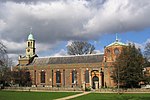Kew Constabulary
1845 establishments in EnglandAll pages needing cleanupPark police forces of LondonParks and open spaces in the London Borough of Richmond upon ThamesRoyal Botanic Gardens, Kew ... and 2 more
Use British English from January 2018Wikipedia introduction cleanup from March 2018
The Kew Constabulary (formerly the Royal Botanic Gardens Constabulary) is a small, specialised constabulary responsible for policing the Royal Botanic Gardens at Kew in Richmond-upon-Thames, England. The constabulary consists of a sworn security manager/chief officer, two section leaders/sergeants, eight constables and four non-sworn operations team members (responsible for CCTV / Control Room / Pass Office). As of 2017, the force had 20 members of staff.
Excerpt from the Wikipedia article Kew Constabulary (License: CC BY-SA 3.0, Authors).Kew Constabulary
Kew Road, London Kew (London Borough of Richmond upon Thames)
Geographical coordinates (GPS) Address Nearby Places Show on map
Geographical coordinates (GPS)
| Latitude | Longitude |
|---|---|
| N 51.475 ° | E -0.29166666666667 ° |
Address
Kew Road 224
TW9 3JX London, Kew (London Borough of Richmond upon Thames)
England, United Kingdom
Open on Google Maps









